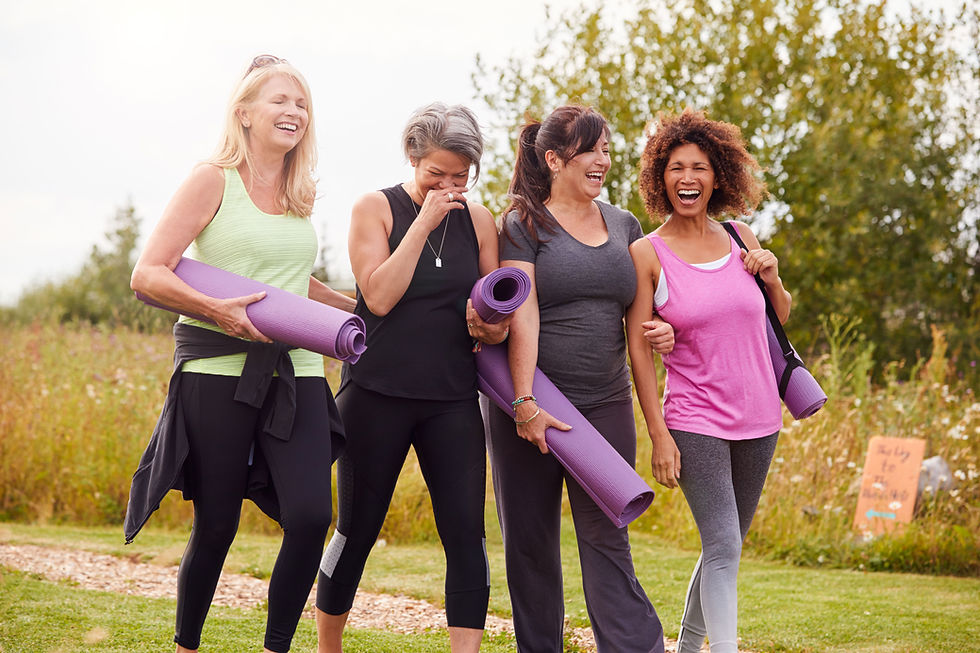From Work to Wellness: At-Home Yoga Poses That Support Hormone Balance
- lhaggard2
- 2 days ago
- 4 min read
How Stress and Hormones Are Connected
If you’re feeling burned out, moody, or struggling with low energy, your hormones may be partly to blame. Stress, poor sleep, and a sedentary lifestyle all throw hormones like cortisol, estrogen, testosterone, and thyroid hormones out of balance.
One of the simplest, most effective ways to restore balance? Yoga.
Yoga doesn’t just stretch muscles, it lowers stress hormones, supports better sleep, and improves circulation, which all play a role in hormone regulation. And the best part? You don’t need a gym or expensive equipment; you can do it all at home.

The Role of Yoga in Balancing Hormones Naturally
Research shows that yoga helps regulate the endocrine system, the network of glands that produces hormones. By reducing stress and improving blood flow to hormone-producing organs like the thyroid, adrenals, and ovaries/testes, yoga creates a foundation for balance.
Benefits include:
Lower cortisol (stress hormone)
Improved insulin sensitivity
Better sleep quality (supports melatonin and growth hormone release)
Boosted mood from serotonin and dopamine regulation
Enhanced energy and libido from improved testosterone and estrogen balance
5 Yoga Poses That Promote Hormone Health
Here are five beginner-friendly poses you can do at home even if you only have 10 minutes a day.
1. Child’s Pose (Balasana) – For Stress Relief
Child’s Pose gently stretches the back and calms the nervous system. By encouraging deep breathing, it lowers cortisol and helps reset the body’s stress response.
How to Do It: Kneel on the floor, sit back on your heels, and fold forward with arms extended. Breathe deeply for 1–2 minutes.
Hormonal Benefits: Reduces cortisol, improves adrenal function, and prepares the body for rest.
2. Bridge Pose (Setu Bandhasana) – For Thyroid and Adrenal Support
Bridge Pose stimulates the thyroid gland while opening the chest and improving circulation. It also energizes the body, making it ideal for fighting fatigue.
How to Do It: Lie on your back with knees bent and feet hip-width apart. Press into your feet, lifting your hips while keeping shoulders grounded. Hold for 30–60 seconds.
Hormonal Benefits: Supports thyroid health, balances estrogen, and boosts energy.
3. Seated Twist (Ardha Matsyendrasana) – For Digestion and Detox
Twists massage internal organs, stimulate digestion, and help the liver detoxify excess hormones like estrogen.
How to Do It: Sit with legs extended, bend your right knee, and place your foot outside your left thigh. Twist your torso toward the bent knee, placing your hand behind you. Hold for 30 seconds, then switch sides.
Hormonal Benefits: Supports liver detox, improves estrogen balance, and enhances digestion.
4. Legs-Up-the-Wall Pose (Viparita Karani) – For Relaxation and Circulation
This restorative pose promotes blood flow to the pelvic region, reduces stress, and improves circulation helping regulate sex hormones and cortisol.
How to Do It: Sit sideways against a wall, swing your legs up, and lie back so your legs rest vertically. Hold for 5–10 minutes.
Hormonal Benefits: Improves circulation to hormone-producing organs, lowers cortisol, and reduces fatigue.
5. Corpse Pose (Savasana) – For Nervous System Reset
Often overlooked, Savasana is the ultimate pose for stress relief. By calming the nervous system, it allows hormones to reset and the body to heal.
How to Do It: Lie flat on your back, arms relaxed by your sides, palms facing up. Focus on deep, slow breathing for 5–10 minutes.
Hormonal Benefits: Balances cortisol and melatonin, promotes deep relaxation, and supports better sleep.
Tips for Building a Hormone-Friendly Yoga Routine
Start small: Even 10 minutes a day makes a difference.
Be consistent: Aim for 3–5 sessions per week.
Focus on breath: Deep breathing amplifies stress-reducing effects.
Combine with lifestyle habits: Good nutrition, sleep, and BHRT maximize results.
If you’re new to yoga, apps like Down Dog or free YouTube classes can guide you step-by-step.
When to Combine Yoga With Medical Support
Yoga is powerful, but it’s not a replacement for medical treatment when hormone imbalances are significant. If you’re dealing with:
Menopause or andropause symptoms
Chronic fatigue
Weight gain despite diet and exercise
Mood swings or depression
…then bioidentical hormone therapy (BHRT) combined with yoga can be life-changing. Yoga reduces stress and inflammation, while BHRT restores hormones to optimal levels. Together, they create balance physically, mentally, and emotionally.
FAQs About Yoga and Hormone Balance
Q: Can yoga replace hormone therapy? No. Yoga supports hormone balance, but BHRT may still be needed for significant imbalances.
Q: How long before I notice results from yoga? Some people feel calmer after their very first session, while long-term benefits like improved sleep and energy build over weeks.
Q: Is yoga safe for beginners over 40? Absolutely. Start with gentle, restorative poses and gradually increase intensity as your body adapts.
Why AgeWait Recommends Yoga Alongside BHRT
At AgeWait, we know that hormone health requires more than prescriptions. That’s why we encourage patients to combine BHRT with stress management techniques like yoga, meditation, and nutrition. This holistic approach helps patients not only feel better faster but also sustain results long term.




Comments